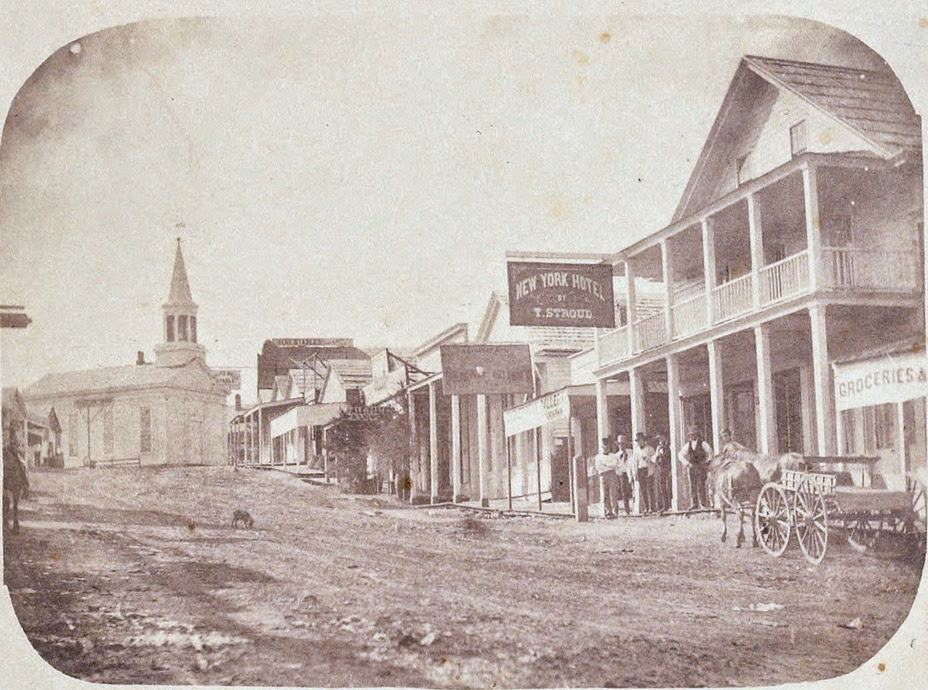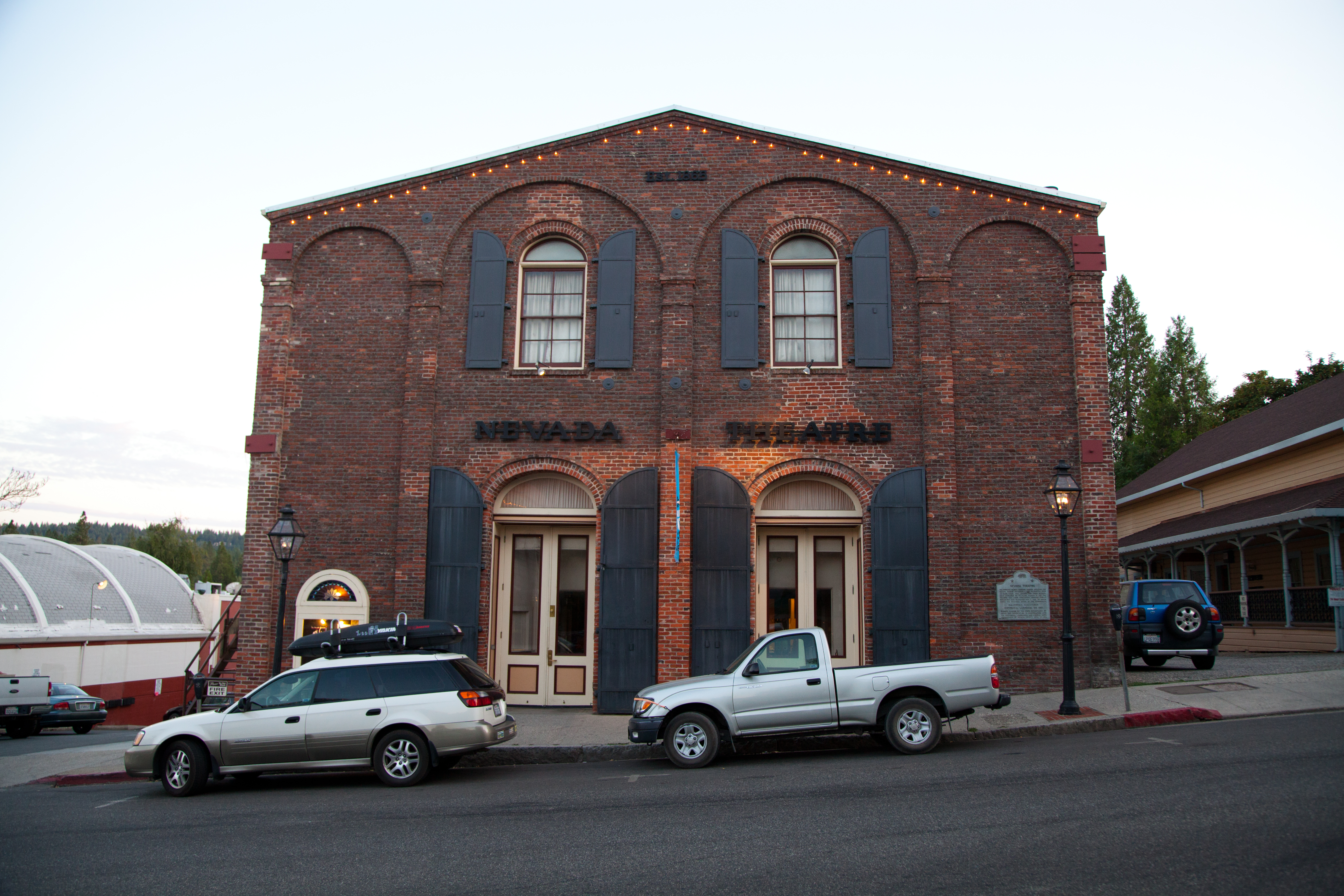|
Nevada City Firehouse No. 2
Nevada City Firehouse No. 2 is a historic firehouse located at 420 Broad Street in Nevada City, California. Built in 1860–61, the firehouse was the first built in Nevada City. At the time, Nevada City had two factions competing for public funds for a firehouse: the Broad Street fire company and a group based on Main Street. While the Main Street company officially organized a day before the Broad Street company, the Broad Street firehouse had more private funding and was completed first, and hence Firehouse No. 2 became the first in the city. The firehouse features a two-story portico in front and a Greek Revival cornice. . The firehouse was added to the National Register of Historic Places on May 3, 1974. It is now operated by the Nevada County Historical Society as a museum of local history. Images Fire House No. 2 (Nevada City, CA).jpg, The firehouse as it appeared in 1936. Nevada City Firehouse Number Two-3.jpg, The firehouse in 2012 NevadaCityCA95959b.jpg, Nevada City Fi ... [...More Info...] [...Related Items...] OR: [Wikipedia] [Google] [Baidu] |
Nevada City, California
Nevada City (originally, ''Ustumah'', a Nisenan village; later, Nevada, Deer Creek Dry Diggins, and Caldwell's Upper Store) is the county seat of Nevada County, California, United States, northeast of Sacramento, southwest of Reno and northeast of San Francisco. The population was 3,068 as of the 2010 Census. History European-Americans first settled Nevada City in 1849, during the California Gold Rush, as Nevada (Spanish for "snow-covered", a reference to the snow-topped mountains in the area). The ''Gold Tunnel'' on the north side of Deer Creek was the city's first mine, built in 1850. The first sawmill in Nevada City was built on Deer Creek, just above town, in August 1850, by Lewis & Son, with a water wheel. In 1850–51, Nevada City was the state's most important mining town, and Nevada County the state's leading gold-mining county. In 1851, '' The Nevada Journal'' became the first newspaper published in the town and county. The first cemetery in town, the Pioneer Cemeter ... [...More Info...] [...Related Items...] OR: [Wikipedia] [Google] [Baidu] |
History Of Nevada City, California
Nevada City (originally, ''Ustumah'', a Nisenan village; later, Nevada, Deer Creek Dry Diggins, and Caldwell's Upper Store) is the county seat of Nevada County, California, United States, northeast of Sacramento, southwest of Reno and northeast of San Francisco. The population was 3,068 as of the 2010 Census. History European-Americans first settled Nevada City in 1849, during the California Gold Rush, as Nevada (Spanish for "snow-covered", a reference to the snow-topped mountains in the area). The ''Gold Tunnel'' on the north side of Deer Creek was the city's first mine, built in 1850. The first sawmill in Nevada City was built on Deer Creek, just above town, in August 1850, by Lewis & Son, with a water wheel. In 1850–51, Nevada City was the state's most important mining town, and Nevada County the state's leading gold-mining county. In 1851, ''The Nevada Journal'' became the first newspaper published in the town and county. The first cemetery in town, the Pioneer Cemetery ... [...More Info...] [...Related Items...] OR: [Wikipedia] [Google] [Baidu] |
Museums In Nevada County, California
A museum ( ; plural museums or, rarely, musea) is a building or institution that cares for and displays a collection of artifacts and other objects of artistic, cultural, historical, or scientific importance. Many public museums make these items available for public viewing through exhibits that may be permanent or temporary. The largest museums are located in major cities throughout the world, while thousands of local museums exist in smaller cities, towns, and rural areas. Museums have varying aims, ranging from the conservation and documentation of their collection, serving researchers and specialists, to catering to the general public. The goal of serving researchers is not only scientific, but intended to serve the general public. There are many types of museums, including art museums, natural history museums, science museums, war museums, and children's museums. According to the International Council of Museums (ICOM), there are more than 55,000 museums in 202 count ... [...More Info...] [...Related Items...] OR: [Wikipedia] [Google] [Baidu] |
Neoclassical Architecture In California
Neoclassical or neo-classical may refer to: * Neoclassicism or New Classicism, any of a number of movements in the fine arts, literature, theatre, music, language, and architecture beginning in the 17th century ** Neoclassical architecture, an architectural style of the 18th and 19th centuries ** Neoclassical sculpture, a sculptural style of the 18th and 19th centuries ** New Classical architecture, an overarching movement of contemporary classical architecture in the 21st century ** in linguistics, a word that is a recent construction from New Latin based on older, classical elements * Neoclassical ballet, a ballet style which uses traditional ballet vocabulary, but is generally more expansive than the classical structure allowed * The "Neo-classical period" of painter Pablo Picasso immediately following World War I * Neoclassical economics, a general approach in economics focusing on the determination of prices, outputs, and income distributions in markets through supply and dema ... [...More Info...] [...Related Items...] OR: [Wikipedia] [Google] [Baidu] |
Greek Revival Architecture In California
Greek may refer to: Greece Anything of, from, or related to Greece, a country in Southern Europe: *Greeks, an ethnic group. *Greek language, a branch of the Indo-European language family. **Proto-Greek language, the assumed last common ancestor of all known varieties of Greek. **Mycenaean Greek, most ancient attested form of the language (16th to 11th centuries BC). **Ancient Greek, forms of the language used c. 1000–330 BC. **Koine Greek, common form of Greek spoken and written during Classical antiquity. **Medieval Greek or Byzantine Language, language used between the Middle Ages and the Ottoman conquest of Constantinople. **Modern Greek, varieties spoken in the modern era (from 1453 AD). *Greek alphabet, script used to write the Greek language. *Greek Orthodox Church, several Churches of the Eastern Orthodox Church. *Ancient Greece, the ancient civilization before the end of Antiquity. *Old Greek, the language as spoken from Late Antiquity to around 1500 AD. Other uses * '' ... [...More Info...] [...Related Items...] OR: [Wikipedia] [Google] [Baidu] |
National Register Of Historic Places In Nevada County, California
__NOTOC__ This is a list of the National Register of Historic Places listings in Nevada County, California. This is intended to be a complete list of the properties and districts on the National Register of Historic Places in Nevada County, California, Nevada County, California, United States. Latitude and longitude coordinates are provided for many National Register properties and districts; these locations may be seen together in an online map. There are 24 properties and districts listed on the National Register in the county, including 1 National Historic Landmark. Current listings See also *List of National Historic Landmarks in California *National Register of Historic Places listings in California *California Historical Landmarks in Nevada County, California References {{Nevada County, California National Register of Historic Places in Nevada County, California, * Lists of National Register of Historic Places in California by county ... [...More Info...] [...Related Items...] OR: [Wikipedia] [Google] [Baidu] |
Fire Stations On The National Register Of Historic Places In California
Fire is the rapid oxidation of a material (the fuel) in the exothermic chemical process of combustion, releasing heat, light, and various reaction Product (chemistry), products. At a certain point in the combustion reaction, called the ignition point, flames are produced. The ''flame'' is the visible portion of the fire. Flames consist primarily of carbon dioxide, water vapor, oxygen and nitrogen. If hot enough, the gases may become ionized to produce Plasma (physics), plasma. Depending on the substances alight, and any impurities outside, the color of the flame and the fire's Intensity (heat transfer), intensity will be different. Fire in its most common form can result in conflagration, which has the potential to cause physical damage through burning. Fire is an important process that affects ecological systems around the globe. The positive effects of fire include stimulating growth and maintaining various ecological systems. Its negative effects include hazard to life and pr ... [...More Info...] [...Related Items...] OR: [Wikipedia] [Google] [Baidu] |


